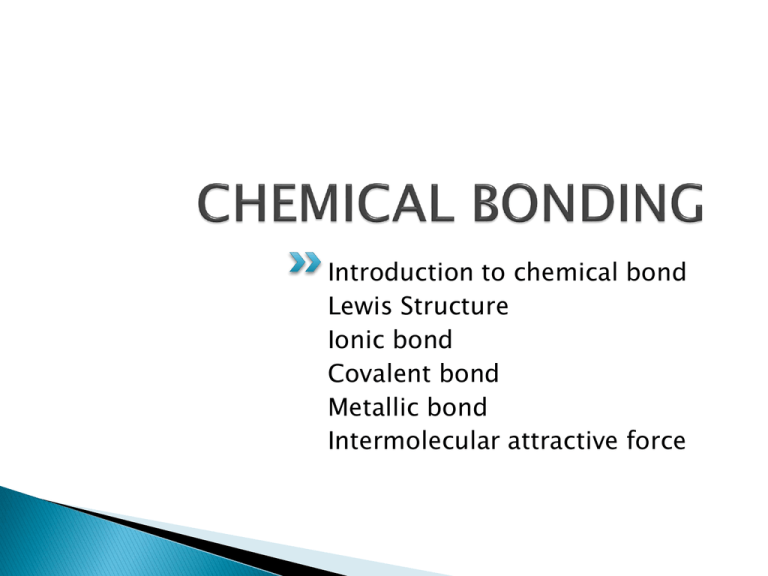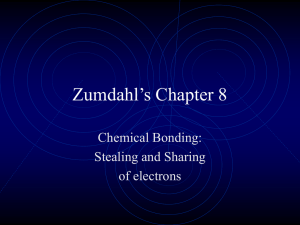2. Chemical Bond
advertisement

Introduction to chemical bond Lewis Structure Ionic bond Covalent bond Metallic bond Intermolecular attractive force H2 chemical bond formation O-H bond formation MXn M diletakkan di tengah sehingga terdapat n M-X ikatan H dan Halogen hanya memiliki 1 ikatan, group 16 2 ikatan, group 15 3 ikatan group 14 4 ikatan Group2 dan group 13 electron deficient Element di bawah Mg hipervalence C,N,O,P,S effective -type overlap Counting electrons The total number of electrons represented in a Lewis structure is equal to the sum of the numbers of valence electrons on each individual atom. Non-valence electrons are not represented in Lewis structures. The octet rule states atoms with eight electrons in their valence shell will be stable, regardless of whether these electrons are bonding or nonbonding. The rule applies well to acidic compounds. The 18-Electron rule is operative on atoms from period 4, which have to achieve 18 electrons to their orbitals and achieve a stable configuration which has the same electron configuration as a Noble gas. Similarly from period 6, the atoms have to achieve 32 electrons to fill their orbitals. Placing electrons Lewis structures for oxygen, fluorine, the hydrogen sulfate anion, and formamide Once the total number of available electrons has been determined, electrons must be placed into the structure. They should be placed initially as lone pairs: one pair of dots for each pair of electrons available. Lone pairs should initially be placed on outer atoms (other than hydrogen) until each outer atom has eight electrons in bonding pairs and lone pairs; extra lone pairs may then be placed on the central atom. When in doubt, lone pairs should be placed on more electronegative atoms first. Once all lone pairs are placed, atoms, especially the central atoms, may not have an octet of electrons. In this case, the atoms must form a double bond; a lone pair of electrons is Examples Tentukan struktur lewis dari : O3 , NO3- , NCO ? PO43-, BrO3F, IO2F2 ? ClO4-, SO42- , PF5 , SF4 ? Hypervalence : P, S, Br Calculate number of bond Jika aturan oktet dipenuhi : number of bond = (total e- needed) –(valence e- available) e- needed 2 = 5x8 = 40 e- available = 6 + 4(7) =34 Number of bonding = (40-34)/2 =3 ? H-C≡N e- needed = 1(2) +2(8) = 18 e- available = 1 + 4 + 5 = 10 Number of bonding = (18-10)/2 =4 ? 'Formal Charge’ is defined as the number of valence electrons minus the number of lone pair electrons minus one half of the bonding electrons. 5-4-2=-1 6-2-3 = +1 6-2-3=+1 6-6-1=-1 The simplest Lewis theory cannot predict this without a 'fix' called resonance. 6-6-1 =-1 Secondary resonance structure S-O bond are chemically and symetrically equivalent, average f.c = -1/2 5-4-2= -1 4-3 = +1 Muatan formal + EN rendah Muatan formal - EN tinggi Li-F H-F Both atoms have 0 formal charges Ionic resonance Mengapa sebuah struktur memiliki muatan parsial? Apa perbedaan antara muatan formal dan muatan parsial? Struktur molekul memiliki muatan parsial jika terbentuk dari element element yang memiliki perbedaan elektronegativitas Intermolecular attractive force Hydrogen bond vs covalence bond Hydrogen bond effect CHCl3 61.2°C CCl4 76.8°C The boiling points of ethanol and methoxymethane show the dramatic effect that the hydrogen bonding has on the stickiness of the ethanol molecules: The hydrogen bonding in the ethanol has lifted its boiling point about 100°C. It is important to realise that hydrogen bonding exists in addition to van der Waals attractions. For example, all the following molecules contain the same number of electrons, and the first two are much the same length. The higher boiling point of the butan-1-ol is due to the additional hydrogen bonding. ethanol (with hydrogen bonding) 78.5°C methoxymethane (without hydrogen bonding) -24.8°C







